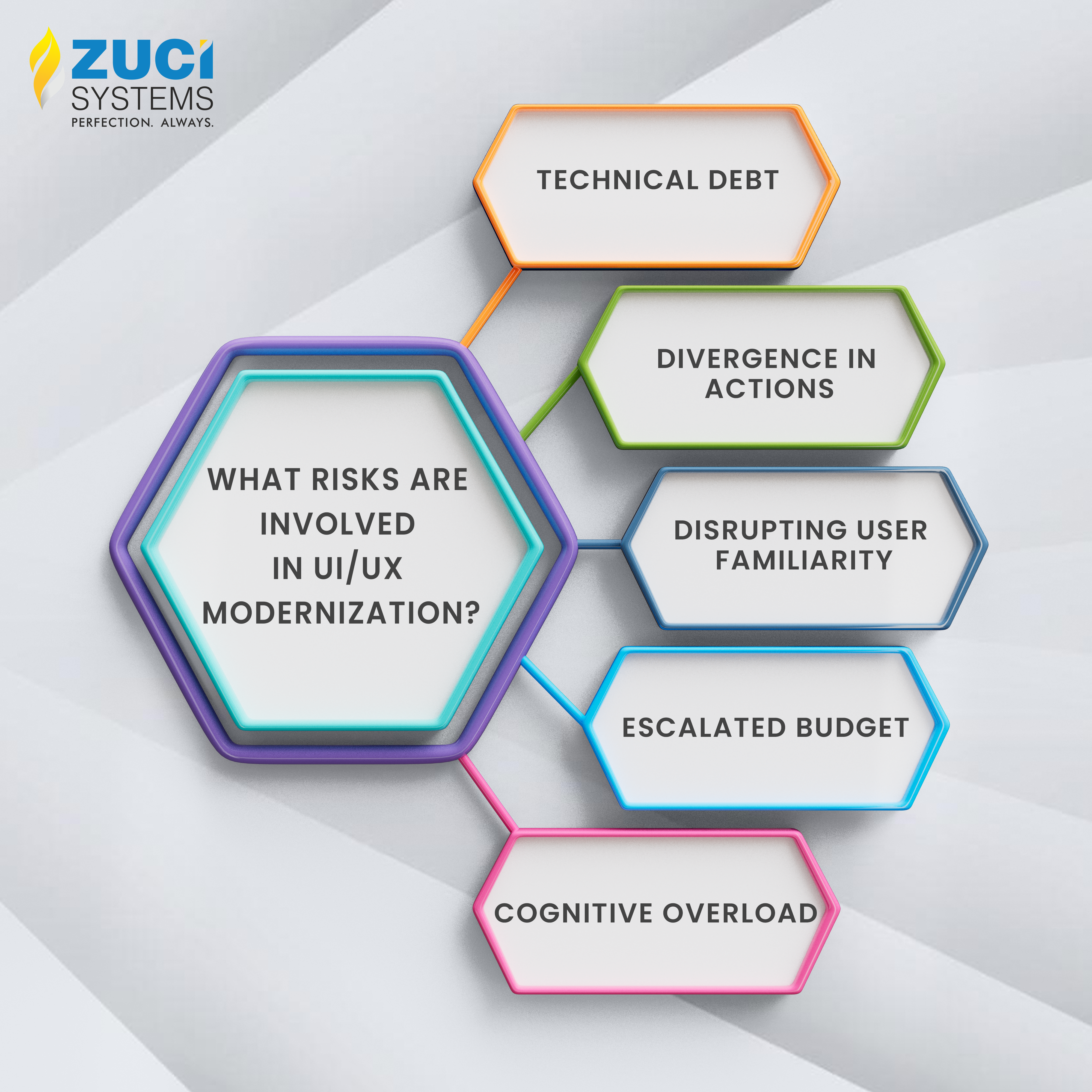UI/UX Modernization – Risks and Approaches
Kavya Ravichandran is a skilled content writer with a flair for crafting narratives that educate and engage. Driven by a love for words and an innate curiosity, she explores various topics in the digital space, focusing on application development and modernization, UI/UX design, and emerging technologies like DevOps, AI, and more. She is adept at tailoring her narratives to suit different audiences and platforms, ensuring her work is both relevant and insightful.
As technology continues to evolve at a breakneck pace, so do user expectations. What delighted users yesterday may not suffice tomorrow. A user-friendly and visually appealing digital experience is no longer a luxury but a fundamental expectation. The need for UI/UX modernization arises from the realization that static and outdated interfaces are no longer sufficient to meet the dynamic demands of contemporary consumers. Neglecting to adapt and enhance UI/UX can expose businesses to a range of detrimental consequences, including dwindling user engagement, diminished customer loyalty, and a compromised competitive edge in the market.
According to a study by McKinsey, 70% of business leaders believe that improving customer experiences through UI/UX is a top priority for their organizations.
Overcoming Challenges in UI/UX Modernization
1. Technical Debt:
Technical debt can significantly impact UI/UX modernization efforts in various ways. Accumulated technical debt, such as outdated or poorly written code, can lead to code complexity and hinder maintainability, making the modernization process more complex and time-consuming. It can also result in inefficient performance, limited flexibility, and compatibility challenges, impacting the integration of new UI/UX elements. Security vulnerabilities in the codebase can put user data at risk. Additionally, addressing technical debt during modernization adds to the overall cost and time-to-market, potentially delaying the improved user experience.
You might also be interested in: How To Manage Technical Debt During Development?
2. Divergence in Actions:
One of the foremost challenges encountered in the process of UI/UX modernization revolves around the contrasting team efforts among diverse teams operating at various stages. It is imperative to convey a coherent understanding of the envisioned UX following modernization across all pertinent departments, thereby engendering a culture of collaboration and effective communication among the design team, developers, and software testers.
3. Disrupting User Familiarity:
Resistance to change is a prevalent and formidable challenge encountered during the process of UI/UX modernization. Users often find solace in the familiar and may harbor apprehensions about embracing new designs, workflows, and technologies. Concerns may arise due to the fear of the unknown, potential disruptions to established workflows, or perceived inefficiencies in adapting to the updated system.
4. Escalated Budget:
Increased costs during UI/UX modernization can have significant effects. Budget constraints may limit resources and project scope, potentially resulting in the exclusion of desired features. Additionally, higher expenses could lead to extended timelines and compromise the overall quality of the UI/UX. This reduced quality may negatively impact user adoption and raise concerns about ROI.
5. Cognitive Overload:
An important consideration during the modernization of UIs is the potential for cognitive overload experienced by users. As modernized interfaces tend to incorporate an increasing number of features and functionalities, users may face challenges in processing and assimilating vast amounts of information. To mitigate this risk, meticulous attention must be given to the design of information architecture, visual hierarchy, and content organization. By carefully structuring and prioritizing elements, designers can alleviate cognitive burden, enabling users to navigate the interface more efficiently and reducing the likelihood of overwhelming experiences.

UI/UX Modernization Approaches
-
Thoroughly assess the existing system and create a detailed plan before starting the modernization process.
Begin by thoroughly understanding the current UI/UX design and functionality of the system. This includes examining all aspects of the user interface, such as navigation, layout, visual design, interaction patterns, and user workflows.
-
Set a clear project scope with well-defined deliverables to avoid scope creep.
Scope creep refers to the uncontrolled expansion of project scope beyond its original boundaries, often resulting in delays, budget overruns, and compromised quality. By setting a clear project scope with well-defined deliverables, you create a structured framework that helps the UI/UX modernization project stay on track and meet its objectives. It allows for efficient resource allocation, timely execution, and the successful delivery of a user-friendly and innovative product that aligns with stakeholder expectations.
-
Prioritize features and changes to focus on the most critical aspects of the modernization.
Conduct user research and gather feedback from stakeholders and end-users. Identify pain points, frequently requested features, and areas that impact user engagement and satisfaction the most. Take into account technical and design constraints, or time constraints that may affect the implementation of certain features. Address high-risk items early to mitigate potential issues.
-
Invest in thorough documentation and knowledge transfer to facilitate a smoother development process.
Investing in clear documentation and knowledge transfer is crucial for a smooth UI/UX modernization process. It helps maintain continuity, improves communication, and enables new team members to quickly understand and contribute to the project. By documenting design guidelines, system details, and using collaborative tools, the team can work together more effectively and make informed decisions. Thorough documentation ensures that vital information is accessible, reducing dependencies on specific individuals and facilitating successful project outcomes.
-
Involve stakeholders and end-users in the design process to ensure the final product meets their expectations and minimizes the need for rework.
Incorporating stakeholders and end-users in the design process is imperative to develop a user-centric product that aligns with their specific needs and requirements. Employing well-defined strategies, including comprehensive user research, interactive workshops that foster collaboration, rigorous user testing to obtain valuable feedback, and consistent communication channels can keep all parties informed of progress and developments throughout the entire modernization process.
-
Consider adopting an iterative development approach, allowing for continuous feedback and improvements.
Adopting an iterative development approach in UI/UX modernization means continuously refining the design based on feedback. It prioritizes user needs, reduces risk and cost, and allows for faster improvements. Break the project into manageable iterations, gather early user feedback, and use data to inform decisions. Stay flexible and collaborate actively for better results.
These aforementioned approaches play a pivotal role in ensuring the development of a seamless, user-friendly, and innovative UI/UX that not only addresses present requirements but also maintains adaptability to future changes and advancements. By adhering to a user-centric approach, actively involving stakeholders and end-users for valuable insights, and adopting an iterative development method for continuous feedback and improvements, the modernization process can yield a UI/UX that is highly responsive to user needs and stays relevant amid evolving demands and technologies.
Final Thoughts:
In conclusion, embarking on a UI/UX modernization journey presents both opportunities and challenges for organizations seeking to thrive in the dynamic digital landscape. While the potential benefits of improved user experiences and competitive advantages are substantial, it is vital to acknowledge and address the inherent risks. These risks include user resistance due to disruption of familiar workflows, technical complexities, and resource constraints. However, by adopting a strategic approach focused on user-centricity and collaboration, these risks can be effectively mitigated. Thorough user research, iterative testing, and involving stakeholders throughout the process are essential steps to ensure a successful modernization effort.
Let’s shape the future of UI/UX together – come partner with us on our UI/UX modernization endeavor!
Other Reads:
Related Posts






















